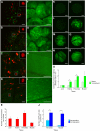High resolution intravital imaging of subcellular structures of mouse abdominal organs using a microstage device
- PMID: 22479464
- PMCID: PMC3313950
- DOI: 10.1371/journal.pone.0033876
High resolution intravital imaging of subcellular structures of mouse abdominal organs using a microstage device
Abstract
Intravital imaging of brain and bone marrow cells in the skull with subcellular resolution has revolutionized neurobiology, immunology and hematology. However, the application of this powerful technology in studies of abdominal organs has long been impeded by organ motion caused by breathing and heartbeat. Here we describe for the first time a simple device designated 'microstage' that effectively reduces organ motions without causing tissue lesions. Combining this microstage device with an upright intravital laser scanning microscope equipped with a unique stick-type objective lens, the system enables subcellular-level imaging of abdominal organs in live mice. We demonstrate that this technique allows for the quantitative analysis of subcellular structures and gene expressions in cells, the tracking of intracellular processes in real-time as well as three-dimensional image construction in the pancreas and liver of the live mouse. As the aforementioned analyses based on subcellular imaging could be extended to other intraperitoneal organs, the technique should offer great potential for investigation of physiological and disease-specific events of abdominal organs. The microstage approach adds an exciting new technique to the in vivo imaging toolbox.
Conflict of interest statement
Figures



References
Publication types
MeSH terms
LinkOut - more resources
Full Text Sources
Molecular Biology Databases
Research Materials

